
| KIT #: | |
| PRICE: | $35-$0 for the kit |
| DECALS: | Several kit options |
| REVIEWER: | Tom Cleaver |
| NOTES: |
Greymatter Figures
Spitfire Type 355 floatplane conversion used (about $75) with Lifelike Decals. |

| HISTORY |
The Spitfire was the descendant of racing seaplanes.
As the war developed, it appeared there were places where a high
performance seaplane fighter might be useful, which led to the development of a
modified Spitfire Vb with landing gear removed and replaced by twin floats known
as the Type 355.
The first time such a conversion was brought up was at the outbreak of
the 1940 Norwegian campaign, where the RAF found itself at a disadvantage
against the Luftwaffe, with very few airfields to operate from during the German
invasion.
Folland Aircraft
undertook the conversion of a Spitfire I, R6722, known as the “Narvik
Nightmare,” using
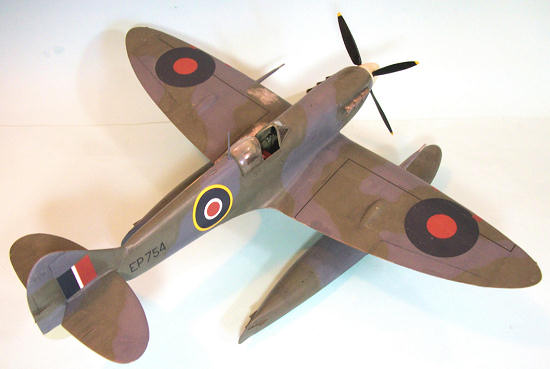 The idea resurfaced in 1942, following a report from Folland Aircraft,
which had continued working on the concept even after cancellation.
This time a Spitfire Vb, W3760, was used for the conversion and used
floats designed by Arthur Shirvall, who had created the high speed floats used
on the S.4., S.5, S.6A and S.6B racing seaplanes.
The initial flight took place on October 12, 1942 in Southampton harbor,
with the standard carburetor intake initially replaced with a tropical Vokes
filter, but this did not protect against water ingestion during takeoff and
landing, and a smaller intake was developed that did keep water out.
It was also found necessary to enlarge and extend the
vertical fin and rudder and a larger ventral fin was added for
directional stability.
Following
these modifications, the prototype began further tests in
The idea resurfaced in 1942, following a report from Folland Aircraft,
which had continued working on the concept even after cancellation.
This time a Spitfire Vb, W3760, was used for the conversion and used
floats designed by Arthur Shirvall, who had created the high speed floats used
on the S.4., S.5, S.6A and S.6B racing seaplanes.
The initial flight took place on October 12, 1942 in Southampton harbor,
with the standard carburetor intake initially replaced with a tropical Vokes
filter, but this did not protect against water ingestion during takeoff and
landing, and a smaller intake was developed that did keep water out.
It was also found necessary to enlarge and extend the
vertical fin and rudder and a larger ventral fin was added for
directional stability.
Following
these modifications, the prototype began further tests in
Fully loaded, the seaplane weighed only 1,100 lbs more than a standard
Spitfire Vb, and maximum speed was only reduced 40 mph, to 324 mph at 19,000
feet.
Maneuverability with the
floats was only slightly less than a standard Spitfire and it was found to be
more maneuverable than any other seaplane.
In the summer of 1943, planning began for an operation using the Spitfire
seaplane against the Germans in the
The three Spitfire seaplanes were transferred to Egypt, arriving at the
base at Kasfareet, were the prototype W3760 remained crated after serious
corrosion was found in the tail unit, while EP751 and EP754 were assembled by
107 Maintenance Unit and taken to the old prewar seaplane station at Fanara on
the Great Bitter Lake in November 1943, where they would be operated.
The unit was equipped with a 40-foot high speed launch powered by two
100hp engines, an all-purpose 22-foot seaplane tender powered by a Ford V8, and
a steam-operated crawler crane to lift the seaplanes onto the concrete dock.
A Walrus was provided for initial seaplane training for the pilots.
Five high-time Spitfire pilots were chosen for the unit, led by Flying
Officer William Lindsay. Training proceeded and the pilots were easily able to
fly the Spitfires after a minimum of experience with the Walrus.
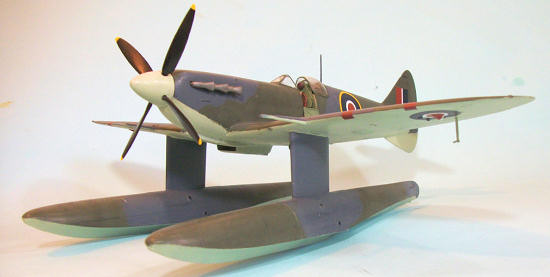 Unfortunately, during training it was found that the floats leaked enough
that the aircraft had to be hauled out of the water to allow them to drain.
While this was not an issue at the seaplane base, it would be a serious
issue at a submarine mooring near a small island in the
Unfortunately, during training it was found that the floats leaked enough
that the aircraft had to be hauled out of the water to allow them to drain.
While this was not an issue at the seaplane base, it would be a serious
issue at a submarine mooring near a small island in the
The idea of the Spitfire on floats did not die.
It was resurrected in 1944 as a possibility for support of invasions in
the Pacific, and Spitfire IX MJ982 was modified as a seaplane and flown in June
1944.
However, the plan died since
by this time the American island-hopping campaign had demonstrated that there
would be fewer amphibious operations and that they were easily supported by
aircraft carriers.
The four Spitfire seaplanes were struck off charge at the end of the war and were all broken up.
| THE KIT |
 Over the years, there have been three Spitfire floatplane kits released
that I am aware of, the most recent being the 1/24 kit by Trumpeter, based on
their godawful Spitfire Vb, which kinda/sorta resembles a Spitfire, if viewed
from a distance no closer than about 3-4 feet away.
PM released a 1/72 kit that is W3760 in its initial configuration with
the Vokes filter and ventral fin with standard rudder and vertical fin.
In about 1994, Gartex - a sub-set of Hasegawa - released a Type 355 that
utilized the Hasegawa Spitfire Vb kit with resin gear well plugs, floats , rear
tail, extended carburetor intake, and 4-bladed prop, with white metal beaching
gear.
I did one of these latter
kits and it looked quite nice.
Over the years, there have been three Spitfire floatplane kits released
that I am aware of, the most recent being the 1/24 kit by Trumpeter, based on
their godawful Spitfire Vb, which kinda/sorta resembles a Spitfire, if viewed
from a distance no closer than about 3-4 feet away.
PM released a 1/72 kit that is W3760 in its initial configuration with
the Vokes filter and ventral fin with standard rudder and vertical fin.
In about 1994, Gartex - a sub-set of Hasegawa - released a Type 355 that
utilized the Hasegawa Spitfire Vb kit with resin gear well plugs, floats , rear
tail, extended carburetor intake, and 4-bladed prop, with white metal beaching
gear.
I did one of these latter
kits and it looked quite nice.
This conversion set from Greymatter was first released by Warbirds several years ago, among their many Spitfire conversions based on the 1/32 Hasegawa Spitfire Vb kit. The set includes floats, pylons, enlarged tail, extended carburetor intake, spinner and four bladed prop in resin, with resin beaching gear. As with their other sets, the parts are well designed and beautifully cast.
| CONSTRUCTION |
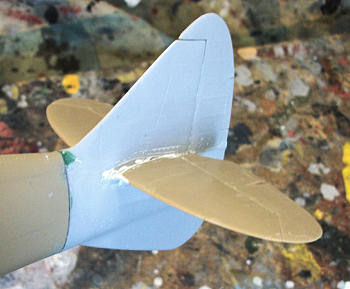 One problem with the tail is that it is a butt join.
There is nothing on the resin part to help in aligning it with the
fuselage.
I used 5 minute epoxy,
and did my best to get it perfectly aligned, and yet it turned out when it was
set (and too late to change) that I was about a half-degree off.
Not really noticeable from any view but dead astern, but if you are not
careful, aligning the horizontal stabs would be a giveaway.
I ended up heating a pan of water and dipping the tail in it, so I could
bend the vertical and ventral fins enough to make it straight, but it’s still
not exactly right.
One problem with the tail is that it is a butt join.
There is nothing on the resin part to help in aligning it with the
fuselage.
I used 5 minute epoxy,
and did my best to get it perfectly aligned, and yet it turned out when it was
set (and too late to change) that I was about a half-degree off.
Not really noticeable from any view but dead astern, but if you are not
careful, aligning the horizontal stabs would be a giveaway.
I ended up heating a pan of water and dipping the tail in it, so I could
bend the vertical and ventral fins enough to make it straight, but it’s still
not exactly right.
The gear well covers were made with Evergreen sheet, which involved
drawing the shape, cutting it out approximately, and then carefully cutting and
sanding to a good fit, after which a liberal application of Squadron Green Stuff
putty was followed with Tamiya surfacer, to get a nice smooth underside of the
wing.
There is the additional fact that the pylons for the pontoons are also a
butt join.
I penciled in the
centerlines of the area, and measured the front attachment point and penciled
that in, then attached the
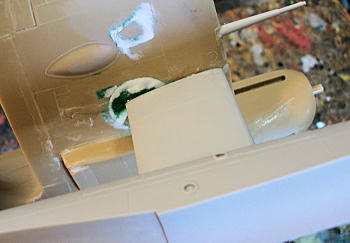 pylons with 5-minute Epoxy.
When they were dry I attached the pontoons.
This was done after completing the wing as a sub-assembly.
pylons with 5-minute Epoxy.
When they were dry I attached the pontoons.
This was done after completing the wing as a sub-assembly.
Once all was assembled, I painted the model in the Temperate Sea Scheme
of Extra Dark Sea Grey, Dark Slate Grey and Sky, using Xtracrylix paints over
Tamiya primer.
The decals came from a Lifelike Decals 1/32 Spitfire sheet, while the
serial number was pieced together from an Xtradecals letters-and-numbers sheet.
I weathered the model per a photo of EP754 found on the net.
Other photos showed the airplanes to be pretty clean during their time in
| CONCLUSIONS |
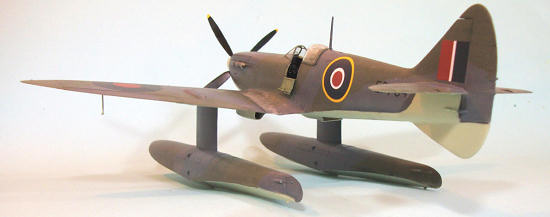 For a Spitfire fanatic, having the Spitfire seaplane in one’s collection
makes the collection complete. The
Greymatter Figures conversion is easy to do for any modeler who has done at
least one other resin conversion and presents no difficulties.
Recommended for all “Boffins.”
For a Spitfire fanatic, having the Spitfire seaplane in one’s collection
makes the collection complete. The
Greymatter Figures conversion is easy to do for any modeler who has done at
least one other resin conversion and presents no difficulties.
Recommended for all “Boffins.”May 2012
Kit courtesy of my billfold.
Conversion set courtesy of Greymatter Figures.
If you would like your product reviewed fairly and fairly quickly, please contact the editor or see other details in the
Note to
Contributors.